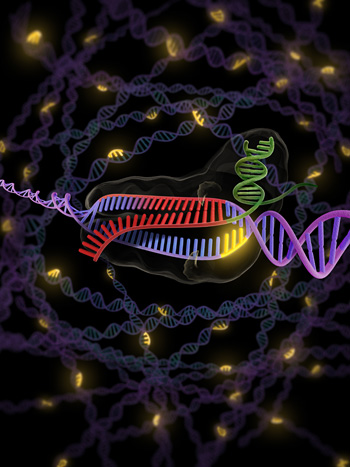
The Nobel Prize Committee announced today that UC Berkeley biochemist Jennifer Doudna has been awarded the 2020 Nobel Prize in Chemistry for her research in developing CRISPR-Cas9. (UC Berkeley photo by Keegan Houser)
University of California, Berkeley, biochemist Jennifer Doudna today won the 2020 Nobel Prize in Chemistry, sharing it with colleague Emmanuelle Charpentier for the co-development of CRISPR-Cas9, a genome editing breakthrough that has revolutionized biomedicine.
CRISPR-Cas9 allows scientists to rewrite DNA — the code of life — in any organism, including human cells, with unprecedented efficiency and precision. The groundbreaking power and versatility of CRISPR-Cas9 has opened up new and wide-ranging possibilities across biology, agriculture and medicine, including the treatment of thousands of intractable diseases.

The bacterial enzyme Cas9 is the engine of RNA-programmed genome engineering in human cells. (Graphic by Jennifer Doudna/UC Berkeley)
Doudna and Charpentier, director of the Max Planck Institute for Infection Biology, will share the 10 million Swedish krona (more than $1 million) prize.
“This great honor recognizes the history of CRISPR and the collaborative story of harnessing it into a profoundly powerful engineering technology that gives new hope and possibility to our society,” said Doudna. “What started as a curiosity‐driven, fundamental discovery project has now become the breakthrough strategy used by countless researchers working to help improve the human condition. I encourage continued support of fundamental science as well as public discourse about the ethical uses and responsible regulation of CRISPR technology.”
Doudna and Charpentier were recognized for their discovery that a gene-cutting molecule, Cas9, used by bacteria to kill viruses, can be re-engineered as a precise and easy-to-use gene-editing tool. The CRISPR-Cas9 system is guided by an RNA molecule to bind a specific region in the DNA, and the Cas9 protein then acts like a pair of molecular scissors to cut the DNA, allowing it to be altered in a precise fashion.
Doudna, who is the Li Ka Shing Chancellor’s Chair in Biomedical and Health Sciences and a Howard Hughes Medical Institute investigator at UC Berkeley, is president and chair of the board of the Innovative Genomics Institute (IGI), a faculty scientist at Lawrence Berkeley National Laboratory (Berkeley Lab), a senior investigator at the Gladstone Institutes and an adjunct professor of cellular and molecular pharmacology at UC San Francisco. Charpentier, who in 2012 was affiliated with the University of Vienna and Umeå University in Sweden, was appointed director of the Max Planck Institute for Infection Biology in Berlin in 2015.
Pursuing fundamental scientific research
Doudna’s research has focused on RNA, a partner to DNA in carrying genetic information and a key part of several molecular machines (such as the ribosome and telomerase) that help DNA do its job. She became interested in CRISPR because of her long-standing interest in such RNA-based machines.
Doudna’s attention was first drawn to CRISPR by a UC Berkeley colleague, Jill Banfield, who encountered it while studying bacteria living in extreme environments. The system intrigued Doudna, who wondered how exactly an unusual repeating sequence of DNA in the bacterial genome enabled bacteria to mount a successful defense against viral infections. What they and other researchers pieced together is that when viruses invade bacteria, the bacteria cut up the viral DNA and place these pieces in their genome, like “most wanted posters.” If similar viruses invade again, roving enzymes with RNA copies of these bits of viral DNA examine the virus and, if the RNA and DNA match, cut the DNA and kill the virus.
Charpentier was focusing on the Type 2 system (CRISPR-Cas9) and, in a paper published in Nature in 2011, described an unusual RNA not found in other CRISPR systems — the tracrRNA (pronounced “tracer RNA”) — and how it works together with the Cas9 protein to help generate the RNA copies of the “most wanted posters.” She and Doudna then considered how the Cas9 protein might also be involved in the final step of CRISPR immunity: surveilling the cell and cutting up invading DNA. The two began their collaboration that year after meeting at a scientific conference in Puerto Rico.
A year later, in a seminal 2012 Science paper, Doudna and Charpentier rocked the scientific community by showing that the protein Cas9 is guided by both the tracrRNA and an RNA matching a viral sequence, which it uses to seek out and destroy matching viral DNA.
Perhaps more importantly, the two scientists also demonstrated that this cellular defense system had applications beyond killing viruses. They engineered the two-piece RNA into a single RNA and showed that it could be designed to pinpoint any gene in any species, not just bacteria, allowing the Cas9 protein to cleave at that spot. Doudna and Charpentier then made the visionary proposal that CRISPR-Cas9 can be repurposed to be an exceptionally powerful tool for editing plant or animal genomes, including human genes, and customized to delete or add specific strands of DNA.
“Jennifer has, for many years, been a pioneering structural biologist in determining the 3D structure and function of RNAs,” said Robert Tjian, a UC Berkeley professor of molecular and cell biology and former head of the Howard Hughes Medical Institute. “Her development of the fused, single-guide RNA was crucial in enabling the efficient and practical use of CRISPR-Cas9 as a highly efficient gene-editing molecular tool. Her further work determining structures of the Cas9/guide-RNA complex has been crucial in further refining this powerful technology.”
In early 2013, Doudna’s UC Berkeley lab and others went on to show that the system could edit human DNA. In the seven years since Doudna and Charpentier’s landmark 2012 paper, CRISPR-Cas technology, as detailed below, has been put to use in nearly every realm of biomedicine, fully validating the power of the colleagues’ vision.
In 2008, Doudna’s nascent research on CRISPR RNA strands and the Cas1 protein was funded by a U.S. Department of Energy (DOE) Laboratory Directed Research and Development (LDRD) Program through her Berkeley Lab affiliation. Established by Congress in 1991, the LDRD program has helped the U.S. remain at the forefront of technology through the innovative, multidisciplinary research of the DOE national labs.
Groundbreaking impact
CRISPR-Cas9 technology has become commonplace in labs around the world because it is remarkably simple to use. Despite its “low barrier to entry,” it is robust in a broad range of settings. In particular, it offers new ways to treat and cure disease, to develop a next generation of crops for a rapidly warming planet and to understand the function of living systems with remarkable speed and clarity.
In medicine, scientists and physicians have used CRISPR-Cas enzymes to precisely alter the genetic code of human cells and organs in a way that bodes clear promise to treat genetic disorders and other diseases. Remarkably, in only seven years, this technology has gone from offering such a promise in theory to being the basis of multiple experimental efforts to treat genetic disease, infectious disease and cancer.
Thousands of labs around the world are already using CRISPR to engineer lab animals with genetics that mimic human disease, so that we can learn how a genetic defect causes symptoms and test ways of correcting the problem.
In agriculture, researchers around the world are applying CRISPR-Cas9 to engineer pest- and disease-resistant crops, as well as crop varieties that are healthier and more nutritious. Highlighting the versatility of CRISPR-Cas technology, the technique is being pursued as the basis of so-called “gene drives” to control mosquito populations and reduce their ability to spread Zika virus and malaria.
In 2015, Doudna was one of the organizers of the first international symposium at the National Academy of Sciences that focused on the societal and ethical use of CRISPR technology. She has been at the forefront of the debate and has argued for inclusive global deliberation before making genetic changes in human sperm, eggs and embryos. She continues to urge the medical and scientific community and the general public to discuss if or when changes to the human germline are acceptable.
Doudna and Charpentier have received numerous awards for their invention, sharing the 2014 Breakthrough Prize in Genetics, the 2015 Gruber Genetics Prize, the 2015 Princess of Asturias Award for Technical and Scientific Research, the 2016 L’Oreal UNESCO For Women in Science Award, the 2016 Canada Gairdner International Award, the 2017 Japan Prize and the 2018 Kavli Prize in Nanoscience.
Doudna has received many other major awards as well, including the Lurie Prize in the Biomedical Sciences, the Dr. Paul Janssen Award for Biomedical Research, the Dr. H. P. Heineken Prize for Biochemistry and Biophysics, and the LUI Che Woo Prize for Welfare Betterment. She is a member of the National Academy of Sciences, the American Academy of Arts and Sciences, the Institute of Medicine and the National Academy of Inventors, and a foreign member of the Royal Society. In 2015, she was named one of the 100 leading global thinkers by Foreign Policy magazine, as well as one of Time magazine’s 100 most influential people.
Born in Washington, D.C., Doudna grew up in Hilo, Hawaii, and developed an interest in chemistry in high school. She graduated from Pomona College in Claremont, California, in 1985 with a degree in biochemistry, then entered graduate school at Harvard University. She earned her Ph.D. in biological chemistry and molecular pharmacology from Harvard Medical School in 1989 and, after various fellowships and postdoctoral positions, joined the Yale University faculty in 1994. She moved to UC Berkeley in 2002.
Doudna lives in Berkeley with her husband, Jamie Cate, a UC Berkeley professor of molecular and cell biology, and their son, Andrew.
RELATED INFORMATION
"in" - Google News
October 07, 2020 at 05:15PM
https://ift.tt/3ddlyV5
Jennifer Doudna wins 2020 Nobel Prize in Chemistry - UC Berkeley
"in" - Google News
https://ift.tt/2MLa3Y1
https://ift.tt/2YrnuUx
Bagikan Berita Ini














0 Response to "Jennifer Doudna wins 2020 Nobel Prize in Chemistry - UC Berkeley"
Post a Comment